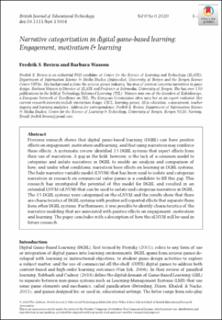| dc.contributor.author | Breien, Fredrik Sundt | |
| dc.contributor.author | Wasson, Barbara | |
| dc.date.accessioned | 2021-02-25T10:35:09Z | |
| dc.date.available | 2021-02-25T10:35:09Z | |
| dc.date.created | 2020-12-14T18:51:37Z | |
| dc.date.issued | 2021 | |
| dc.Published | British Journal of Educational Technology (BJET). 2020, 0 (0), 1-21. | |
| dc.identifier.issn | 0007-1013 | |
| dc.identifier.uri | https://hdl.handle.net/11250/2730336 | |
| dc.description.abstract | Previous research shows that digital game-based learning (DGBL) can have positive effects on engagement, motivation, and learning and that using narratives may reinforce these effects. A systematic review identified 15 DGBL systems that report effects from their use of narratives. A gap in the field, however, is the lack of a common model to categorize and isolate narratives in DGBL to enable an analysis and comparison of how, and under what conditions, narratives have effects on learning in DGBL systems. The ludo narrative variable model (LNVM) that has been used to isolate and categorize narratives in research on commercial video games is a candidate to fill this gap. This research has investigated the potential of this model for DGBL and resulted in an extended LNVM (eLNVM) that can be used to isolate and categorize narratives in DGBL. The 15 DGBL systems were categorized on the eLNVM and the results show that there are characteristics of DGBL systems with positive self-reported effects that separate them from other DGBL systems. Furthermore, it was possible to identify characteristics of the narrative modeling that are associated with positive effects on engagement, motivation, and learning. The paper concludes with a description of how the eLNVM will be used in future research. | en_US |
| dc.language.iso | eng | en_US |
| dc.publisher | Wiley | en_US |
| dc.relation.uri | https://bera-journals.onlinelibrary.wiley.com/doi/epdf/10.1111/bjet.13004 | |
| dc.rights | Navngivelse-Ikkekommersiell 4.0 Internasjonal | * |
| dc.rights.uri | http://creativecommons.org/licenses/by-nc/4.0/deed.no | * |
| dc.title | Narrative categorization in digital game-based learning: Engagement, motivation & learning | en_US |
| dc.type | Journal article | en_US |
| dc.type | Peer reviewed | en_US |
| dc.description.version | publishedVersion | en_US |
| dc.rights.holder | Copyright 2020 The Authors. | en_US |
| cristin.ispublished | true | |
| cristin.fulltext | original | |
| cristin.qualitycode | 1 | |
| dc.identifier.doi | 10.1111/bjet.13004 | |
| dc.identifier.cristin | 1859714 | |
| dc.source.journal | British Journal of Educational Technology (BJET) | en_US |
| dc.source.40 | 0 | |
| dc.source.14 | 0 | |
| dc.source.pagenumber | 91-111 | en_US |
| dc.relation.project | Norges forskningsråd: 277769 | en_US |
| dc.identifier.citation | British Journal of Educational Technology. 2021, 52 (1), 91-111. | en_US |
| dc.source.volume | 52 | en_US |
| dc.source.issue | 1 | en_US |

